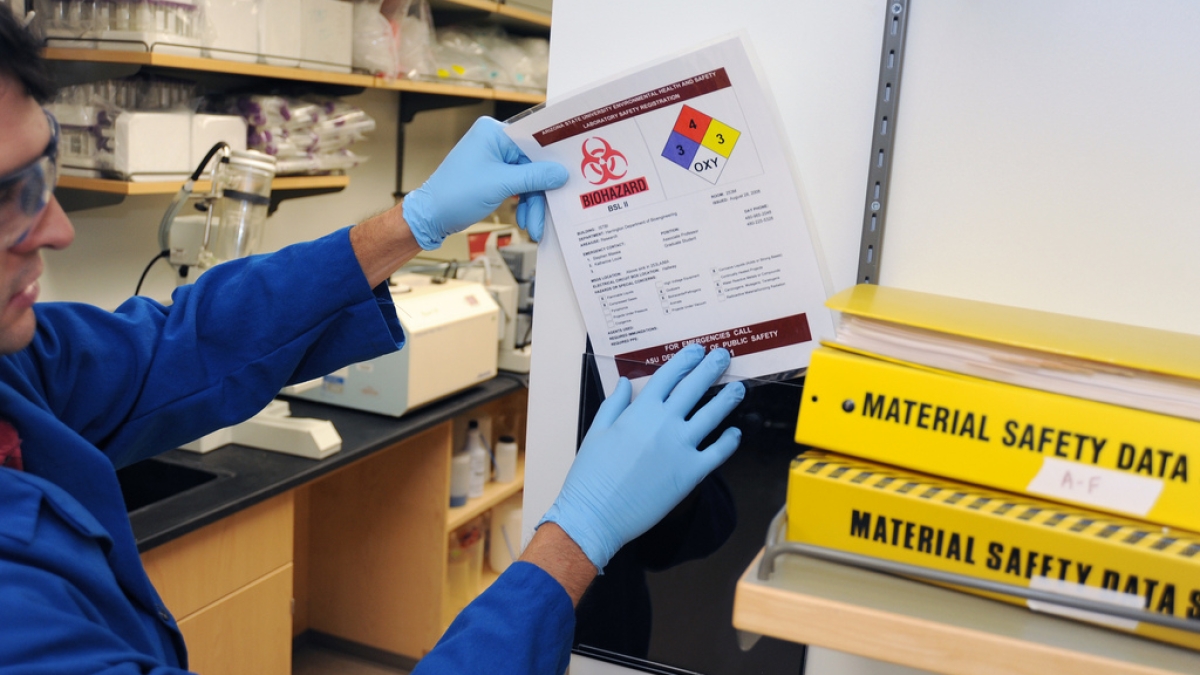UCLA lab tragedy strengthens ASU safety awareness

This June, UCLA professor Patrick Harran and the University of California Board of Regents are expected in court. According to The Los Angeles Times, it’s anticipated that Harran and the regents will reach a plea agreement with prosecutors for charges stemming from the laboratory-fire death of Sheharbano “Sheri” Sangji, a 23-year-old UCLA staff research assistant. Sangji died from extensive burns 18 days after the 2008 lab incident.
Nearly 400 miles from the UCLA tragedy, news of the lab death rattled leadership in the Department of Environmental Health and Safety (EH&S) at Arizona State University.
According to Leon Igras, ASU's EH&S director, professor Harran and the California regents face three felony counts of willfully violating occupational health and safety standards causing an employee death.
“They are accused of failing to correct known unsafe work conditions in a timely manner, failing to require clothing appropriate for the work being done and failing to provide proper chemical safety training,” Igras said.
Before the UCLA tragedy, it was not commonplace for university safety officials to believe that faculty or staff may face criminal charges related to on-campus lab accidents.
“The court case is thought to be the first linked to a higher education lab accident where criminal, felony charges were filed,” said Robert Ott, associate director of Occupational Health and Safety at ASU.
In the more than 1,400 ASU labs, activities include everything from laser and radiation use, to chemical and biological procedures as well as geotechnical and material testing operations. After Sangji’s unfortunate death, EH&S monitored and implemented health and safety enhancements that were very similar to those that UCLA instituted following the fatal fire.
“We immediately issued a safety alert to the EH&S Compliance Officer team to ensure that the ASU community was aware of the potential risk,” Ott said. “Fortunately, the use of the pyrophoric liquid involved in the UCLA incident was relatively limited at ASU and personnel involved were managing the risk.”
Pyrophoric liquids pose a significant risk of catching fire when exposed to the air. If individuals handling volatile chemicals in the lab do not follow proper procedures and wear the proper safety gear, there is a greater risk of serious injury or illness. For instance, EH&S has a Chemical Hygiene Plan that outlines safe work practices and requirements for the use of eye protection and proper laboratory attire.
EH&S then collaborated with the ASU Department of Chemistry and Biochemistry to provide hands-on training for potential users of pyrophoric liquids from other departments.
After the 2008 lab tragedy, EH&S also conducted follow-up lab-safety inspections 30 days following initial reviews. According to Ott, the program enhancement helped lab personnel identify corrective actions and ensure that there was no confusion about rectifying inspection findings.
“Significant laboratory incidents can stifle important research if a lab or building is completely shut down,” Ott said. “Our annual laboratory-safety training is updated to reflect what was learned from the previous year’s inspection findings and any incident that may have occurred. We do this to continually improve our laboratory-safety programs.”
Data collected from the lab inspections then is summarized and trended for EH&S committees and the EH&S Compliance Officer team. Since 2005, the Compliance Officer team – that currently consists of 125 departmental volunteers – has been in place at ASU. Their duties involve managing environmental health and safety activities, including authority to establish processes, investigate complaints and incidents, and audit performance.
John Crozier is a lab safety inspector for EH&S. Before his current post, he was a Compliance Officer for all of the Ira A. Fulton Schools of Engineering. He was required to be knowledgeable in all areas including occupational, environmental, hazardous materials, lab, fire, radiation, biological and shop safety. Last fall, Crozier helped local fire officials quell a liquid nitrogen leak on the Tempe campus.
“The ASU Fire Marshal James Gibbs contacted me at home when he could not reach the lab researchers,” Crozier said. “I believe that my familiarity with the lab and its associated hazards ultimately was helpful to the Tempe Fire Department in planning their response.”
Liquid nitrogen is not combustible, but can cause its handlers cold burns or asphyxiation in poorly ventilated areas – and we were fortunate that no one was injured during the leak, Crozier adds.
Crozier’s dedication to his Compliance Officer role is just one example of how employees are keeping labs safe and incident-free across ASU’s campuses.
According to Igras, 60 percent of ASU Compliance Officers have remained in their positions for two or more years.
“With their continued support and in combination with the efforts of our full-time EH&S employees, we will remain working to ensure that our labs are operating safely and in effect, mitigating serious incidents or injuries,” Igras said. “The death of Sheri Sangji is a tragic lesson to all of us that lab-safety compliance deserves our upmost attention and we hold it in the highest regard.”
For more information about the EH&S Compliance Officer program at ASU, visit: http://cfo.asu.edu/ehs-compliance-officer-program. Visit http://cfo.asu.edu/ehs-training to learn more about EH&S Training classes at ASU.